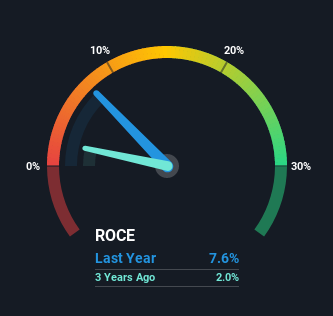- Poland
- /
- Food and Staples Retail
- /
- WSE:ATP
Atlanta Poland (WSE:ATP) Has More To Do To Multiply In Value Going Forward
What trends should we look for it we want to identify stocks that can multiply in value over the long term? Ideally, a business will show two trends; firstly a growing return on capital employed (ROCE) and secondly, an increasing amount of capital employed. Put simply, these types of businesses are compounding machines, meaning they are continually reinvesting their earnings at ever-higher rates of return. In light of that, when we looked at Atlanta Poland (WSE:ATP) and its ROCE trend, we weren't exactly thrilled.
Return On Capital Employed (ROCE): What is it?
For those who don't know, ROCE is a measure of a company's yearly pre-tax profit (its return), relative to the capital employed in the business. To calculate this metric for Atlanta Poland, this is the formula:
Return on Capital Employed = Earnings Before Interest and Tax (EBIT) ÷ (Total Assets - Current Liabilities)
0.076 = zł9.5m ÷ (zł175m - zł51m) (Based on the trailing twelve months to March 2021).
So, Atlanta Poland has an ROCE of 7.6%. In absolute terms, that's a low return and it also under-performs the Consumer Retailing industry average of 10%.
See our latest analysis for Atlanta Poland

Historical performance is a great place to start when researching a stock so above you can see the gauge for Atlanta Poland's ROCE against it's prior returns. If you're interested in investigating Atlanta Poland's past further, check out this free graph of past earnings, revenue and cash flow.
The Trend Of ROCE
Over the past five years, Atlanta Poland's ROCE and capital employed have both remained mostly flat. Businesses with these traits tend to be mature and steady operations because they're past the growth phase. So unless we see a substantial change at Atlanta Poland in terms of ROCE and additional investments being made, we wouldn't hold our breath on it being a multi-bagger.
On another note, while the change in ROCE trend might not scream for attention, it's interesting that the current liabilities have actually gone up over the last five years. This is intriguing because if current liabilities hadn't increased to 29% of total assets, this reported ROCE would probably be less than7.6% because total capital employed would be higher.The 7.6% ROCE could be even lower if current liabilities weren't 29% of total assets, because the the formula would show a larger base of total capital employed. So while current liabilities isn't high right now, keep an eye out in case it increases further, because this can introduce some elements of risk.
Our Take On Atlanta Poland's ROCE
In a nutshell, Atlanta Poland has been trudging along with the same returns from the same amount of capital over the last five years. Since the stock has gained an impressive 88% over the last five years, investors must think there's better things to come. Ultimately, if the underlying trends persist, we wouldn't hold our breath on it being a multi-bagger going forward.
If you want to continue researching Atlanta Poland, you might be interested to know about the 3 warning signs that our analysis has discovered.
If you want to search for solid companies with great earnings, check out this free list of companies with good balance sheets and impressive returns on equity.
New: Manage All Your Stock Portfolios in One Place
We've created the ultimate portfolio companion for stock investors, and it's free.
• Connect an unlimited number of Portfolios and see your total in one currency
• Be alerted to new Warning Signs or Risks via email or mobile
• Track the Fair Value of your stocks
Have feedback on this article? Concerned about the content? Get in touch with us directly. Alternatively, email editorial-team (at) simplywallst.com.
This article by Simply Wall St is general in nature. We provide commentary based on historical data and analyst forecasts only using an unbiased methodology and our articles are not intended to be financial advice. It does not constitute a recommendation to buy or sell any stock, and does not take account of your objectives, or your financial situation. We aim to bring you long-term focused analysis driven by fundamental data. Note that our analysis may not factor in the latest price-sensitive company announcements or qualitative material. Simply Wall St has no position in any stocks mentioned.
About WSE:ATP
Atlanta Poland
Trades in and retails nuts and dried fruits for the confectionery and bakery industries in Poland.
Adequate balance sheet average dividend payer.
Market Insights
Community Narratives



